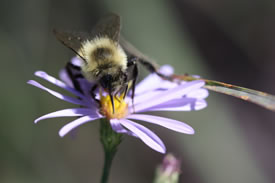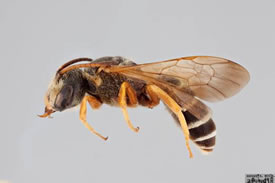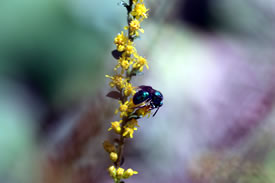The rapid return of bees to an early restored NCC property

Bombus (Photo by Sheila R. Colla)
I started working on a Nature Conservancy of Canada (NCC) property in the South Walsingham area of Norfolk County in 2007. It is a unique 400-acre (160-hectare) property. Historically, 150 acres (60 hectares) of the property were used to grow tobacco, corn and soya beans. The last growing season was May-September 2006.
During the fall of 2006 the agricultural fields were prepared for planting by discing and packing and were then seeded with a diverse mix of native plant species. Since 2006 the site has been regenerating naturally. The long-term goal is to restore the site to oak savannah habitat. Invasive plants species such as garlic mustard are removed from the site each year.
Over the course of two consecutive years, I completed insect biodiversity surveys as part of my overall Ph.D. work at York University, examining the effects of restoration practises on bee community composition. Specifically my Ph.D. was looking at the effect of fire disturbances on bee communities in oak savannah habitats. I started sampling at the NCC property to establish a comparison of mature oak savannah habitat in southern Ontario to habitat in early stages of restoration.
The purpose was to:
- provide further insight into how bee faunas respond to restoration;
- examine how bee communities re-colonize a habitat;
- assess bee community composition overall and whether different guilds (groups) or species within a guild return to early restoration habitat differently.
Bees are the most important animal pollinators, with over 20,000 known species of bees globally. They are present on every continent except Antarctica. Repeated surveys provide important ways of indicating changes in community structure over time.
Intensive biodiversity surveys are important in order to understand whether bee communities are healthy. These studies are one of the most important endeavors to ensure pollination services are sustained. Collecting at the recently restored NCC property and two other mature oak savannah remnants took place every 10 days to ensure that all species’ flight periods were sampled from May until September 2007-2008, with a total of 12 samples per year.
After the second field season was complete and all specimens were identified, specimens collected at the NCC property represented 23 genera and 92 species. The mature oak savannah remnants that were also collected at the same time had 23 genera and 119 species at remnant #1 and remnant #2 had 22 genera and 110 species. The number of genera and species found at the NCC property were quite significant, given the habitat was in the early stages of being restored.
Surprisingly, as the number of species found at the NCC property was so similar to that found in mature remnants, I wanted to further investigate how similar bee communities and specific groups (guilds) of bees responded to restoration at early restored habitat compared to those in mature, established remnants.
To look at the changes in bee guilds, bee species were divided into several common guilds:
- solitary ground nesting species
- social ground nesters
- cavity nesters
- bumblebees
- cleptoparasites
The NCC restored fields showed similar community structure, and the number of species representing each guild was similar to that found in the established remnants.

Halacticus parallelus (Photo courtesy of Laurence Packer, York University)
While I was identifying the specimens over the two collecting years, my supervisor professor Laurence Packer noticed individuals of Halictus parallelus, a social ground nester that was thought to be extremely rare in Canada. This caught our attention and I noticed from specimen tags that individuals were only collected at the NCC property in both years. This was quite surprising as one of the mature oak savannah remnants I surveyed during the same time period was relatively close and no individuals of this species were found at the mature habitat.
These findings show that environmental conditions found at the restored fields appear to be playing a principal role in the nesting and foraging choices of H. parallelus.

Halictid (Photo by Sheila R Colla)
One of the most interesting results was how quickly bee species responded to restoration treatments. It was expected that bee diversity on the restored property would be lower than established mature habitat and over time return to a composition similar to mature habitat. However, it was not anticipated that bee biodiversity within two years would be so similar to those of mature habitat. Overall the intense insect surveys I completed at the NCC property proved to be successful and provided a great deal of insight into how bee communities respond to restoration practices.


